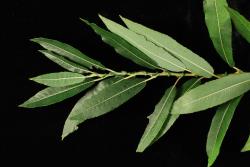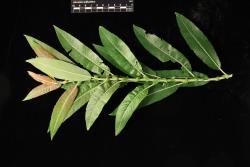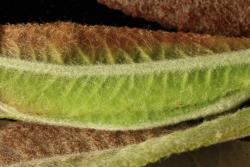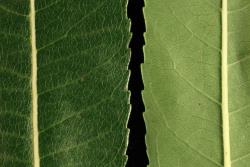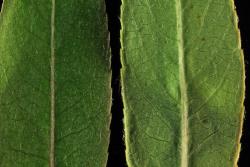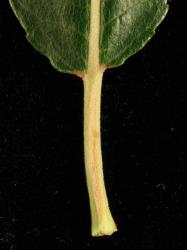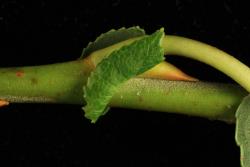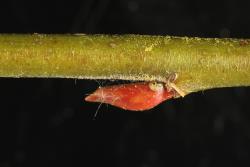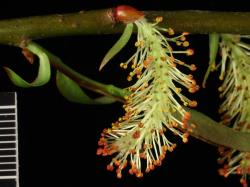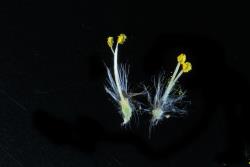- = Salix rigida Muhl., Neue Schriften Ges. Naturf. Freunde Berlin 4: 237, pl. 6, f. 4 (1803)
(Based on PN232 and PN376 in the National Willow Collection): Shrub to 6 m. Current year's branchlets densely velvety, becoming glabrous, new growth initially green, becoming greyish olive to moderate olive. Flower buds 5.8 mm long, 2.2 mm wide, 2.0 mm deep, ovoid, only vaguely keeled, dark reddish orange (UCL38), glabrous. Leaf buds glabrous. Leaves alternate. Stipule persistent, 6–13 mm long, asymmetrically ovate, toothed. Petiole 5–20 mm long, densely tomentose on upper surface, sparse elsewhere, groove absent, glands absent, pale yellow, base not expanded. Emerging leaves strongly tinged with red, with densely tomentose hairs. Proximal leaves toothed. Leaf lamina 112–128 mm long, 31–43 mm wide, length to width ratio 2.9–4.1:1, narrowly elliptical, narrowly ovate, narrowly obovate, or narrowly ovate-oblong, not falcate; base truncate; apex acute; leaf galls absent; margins densely serrulate, plane; upper lamina surface very finely rugose, midvein and side-veins raised, slightly glossy, glabrous except tomentum on midvein, stomata absent; lower lamina surface netted veins visible, not raised, not glaucous but pale green due to dense stomata, glabrous. Catkins slightly precocious. Flowering branch 22–25 mm long, 2 leaves on flowering branch. Male catkin 18–23 mm long, 9 mm diameter; catkin rachis not visible between flowers. Flower bract 2.0 mm long, 0.6 mm wide, hyaline except black at the apex, flat; apex acute, densely long-silky on both surfaces and margins. Male nectary 1, 0.6 mm long, 0.34 mm wide, green. Stamens 2, filaments free, filament hairs absent; anthers 0.85 mm long, orange-red.
The current year's branchlets are green, densely velvety, and the hairs persist. Stipules are conspicuous and persistent, 6 mm long, asymmetrically ovate, finely toothed, and clasp the stem. Leaves are narrowly ovate-oblong, rounded to truncate at their base, and are acuminate at the apex. Leaves are almost glabrous, but tomentum is present on the upper surface midvein. The petiole is densely velvety on all sides and glands are absent. Stomata are absent from upper surface but dense on lower surface giving a pale green look. The lower leaf surface is not glaucous. Young leaves are tinted orange or red and densely tomentose at emergence but the tomentum does not persist. Catkins are oblong, flower bracts have dense silky hairs and become black at the apex. There are two anthers, which are orange-red before opening.
Similar to Salix eriocephala × S. petiolaris. Both have red current year's branchlets, almost glabrous leaves that have a leathery texture, and lack stomata on the upper leaf surface. The hybrid has narrower leaves, 10–19 mm wide and a length to width ratio of 5.5–9.7:1, while S. eriocephala has leaves 31–43 mm wide and a length to width ratio of 2.9–4.1:1.
In cultivation in Southern North Island (Aokautere); there are no other New Zealand records.
First collection: CHR 644817, D. Glenny, L. Newstrom-Lloyd, T. Jones, 12 October 2016, Aokautere.
First publication: This publication.
Flowering: Early September–mid-November (PN376); mid-October–early December (PN232).
Diploid, 2n = 38 (CCDB based on four counts), provisionally confirmed by flow cytometry using PN232 and PN376, which are both diploid.



